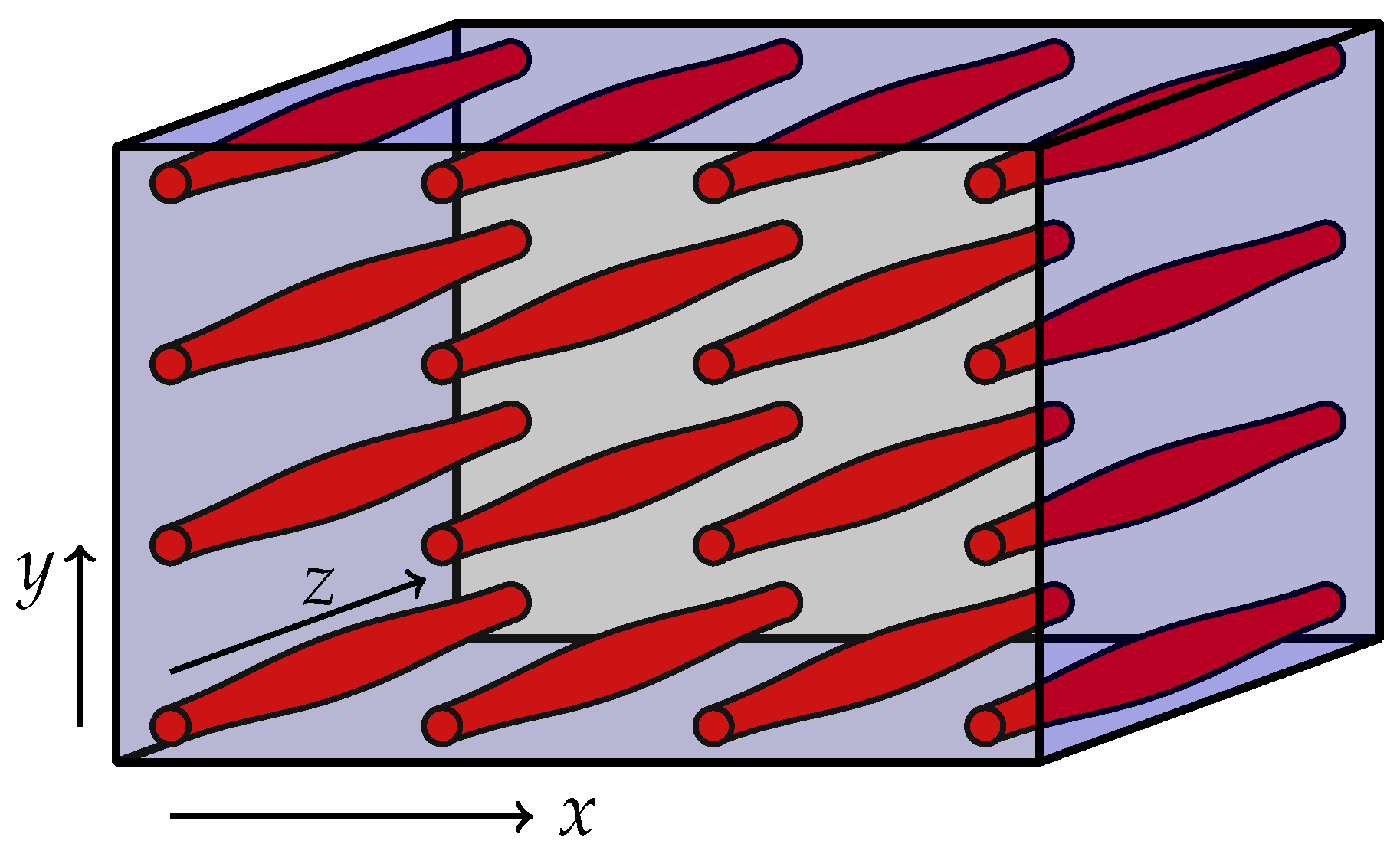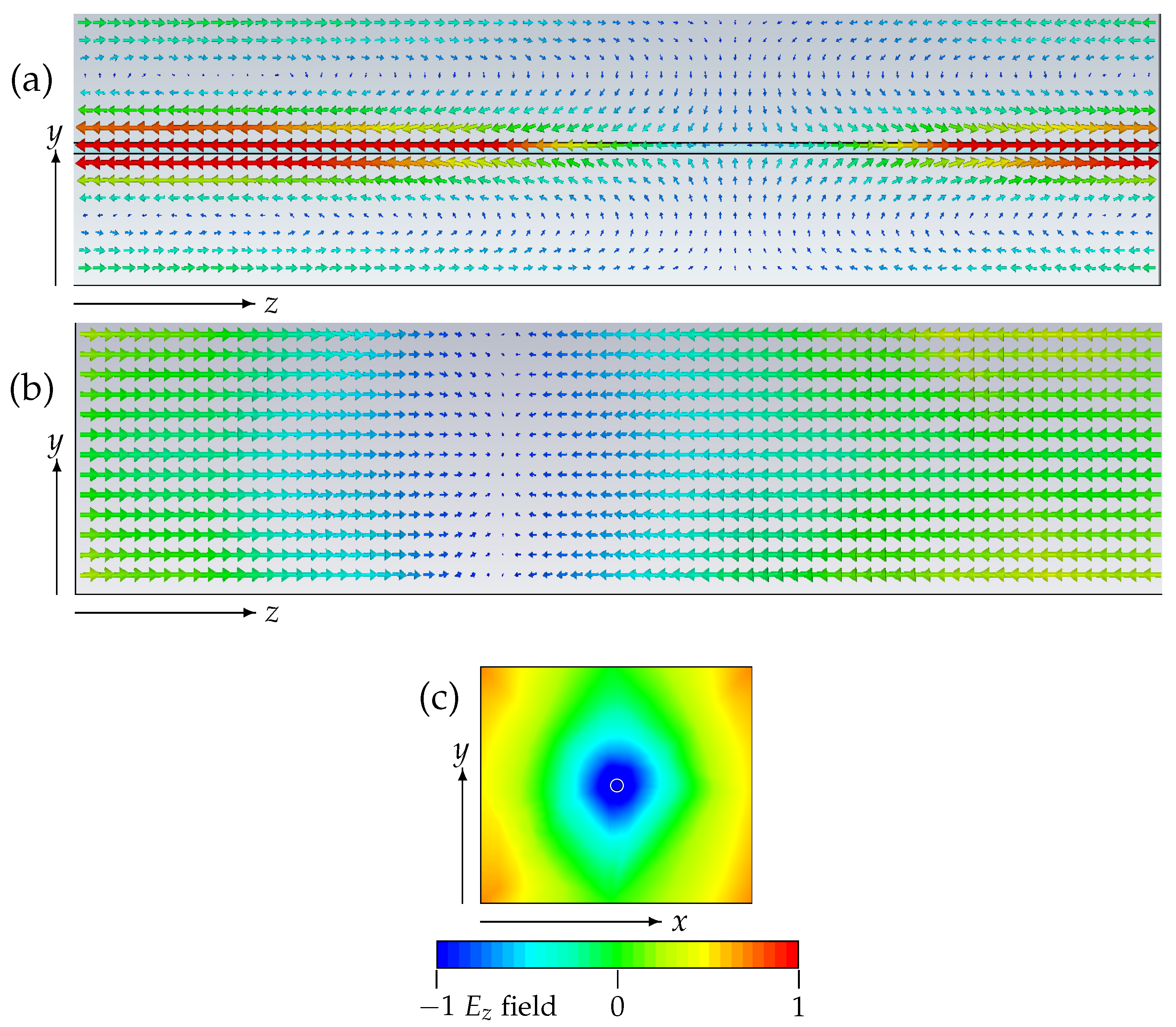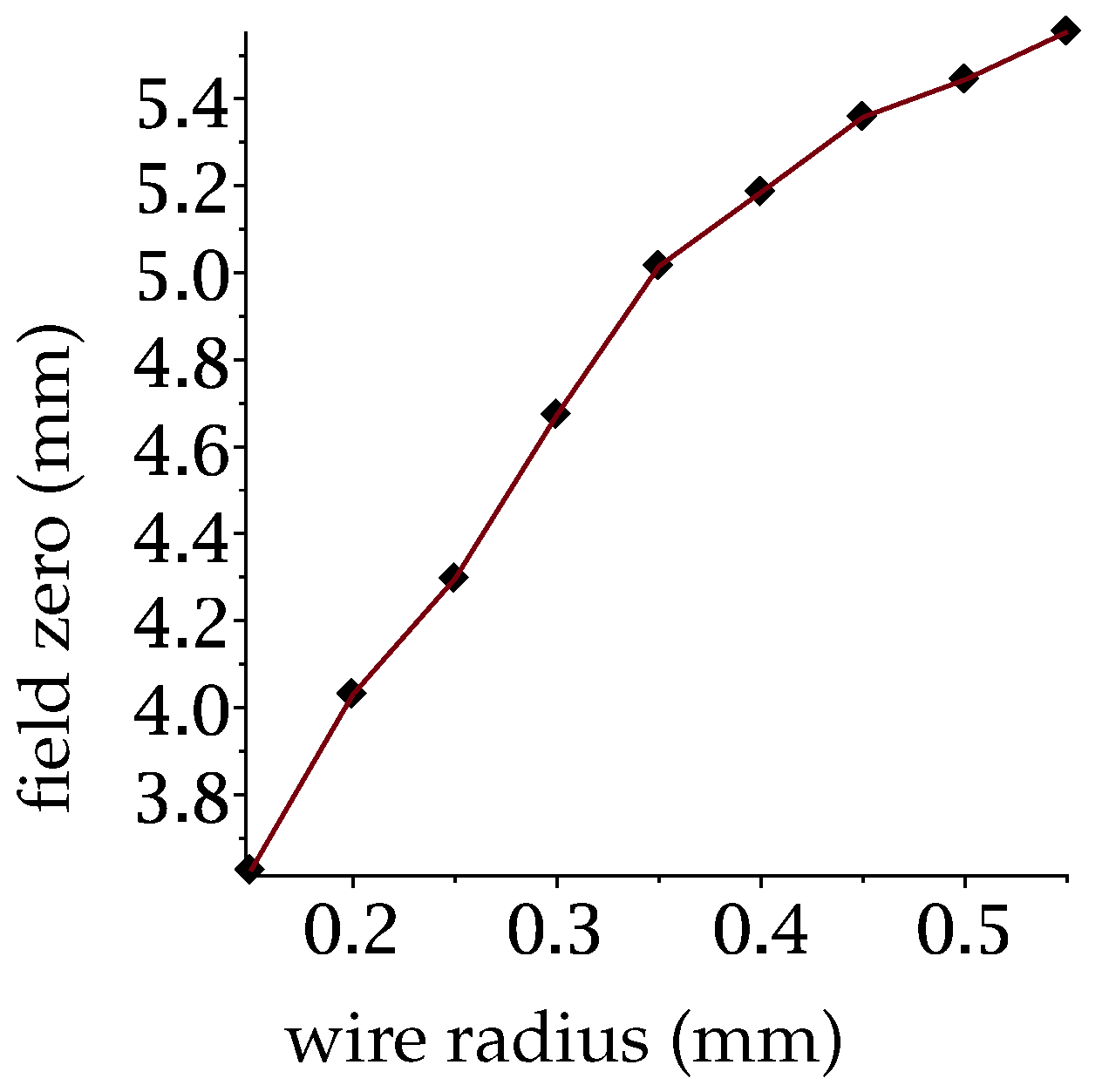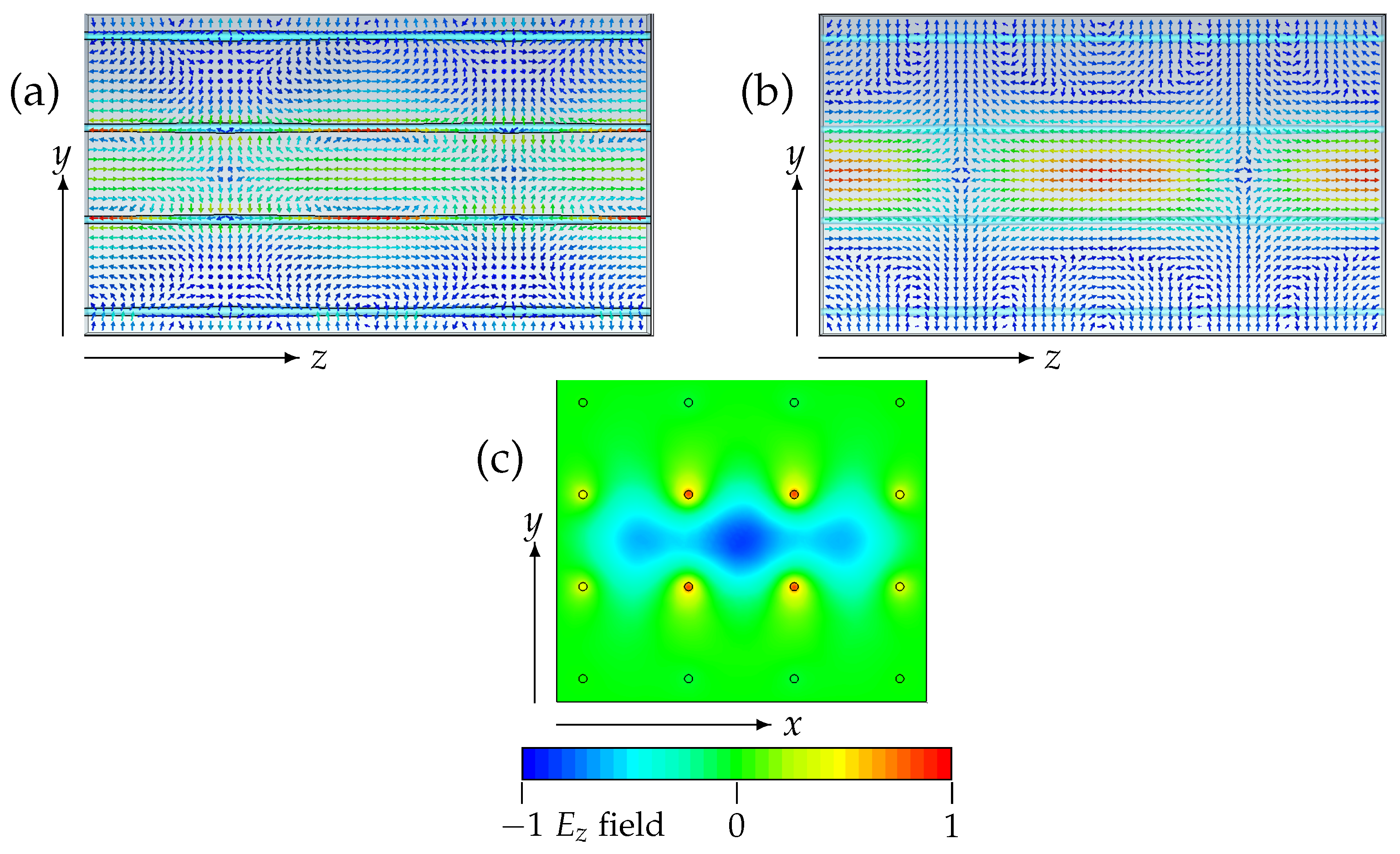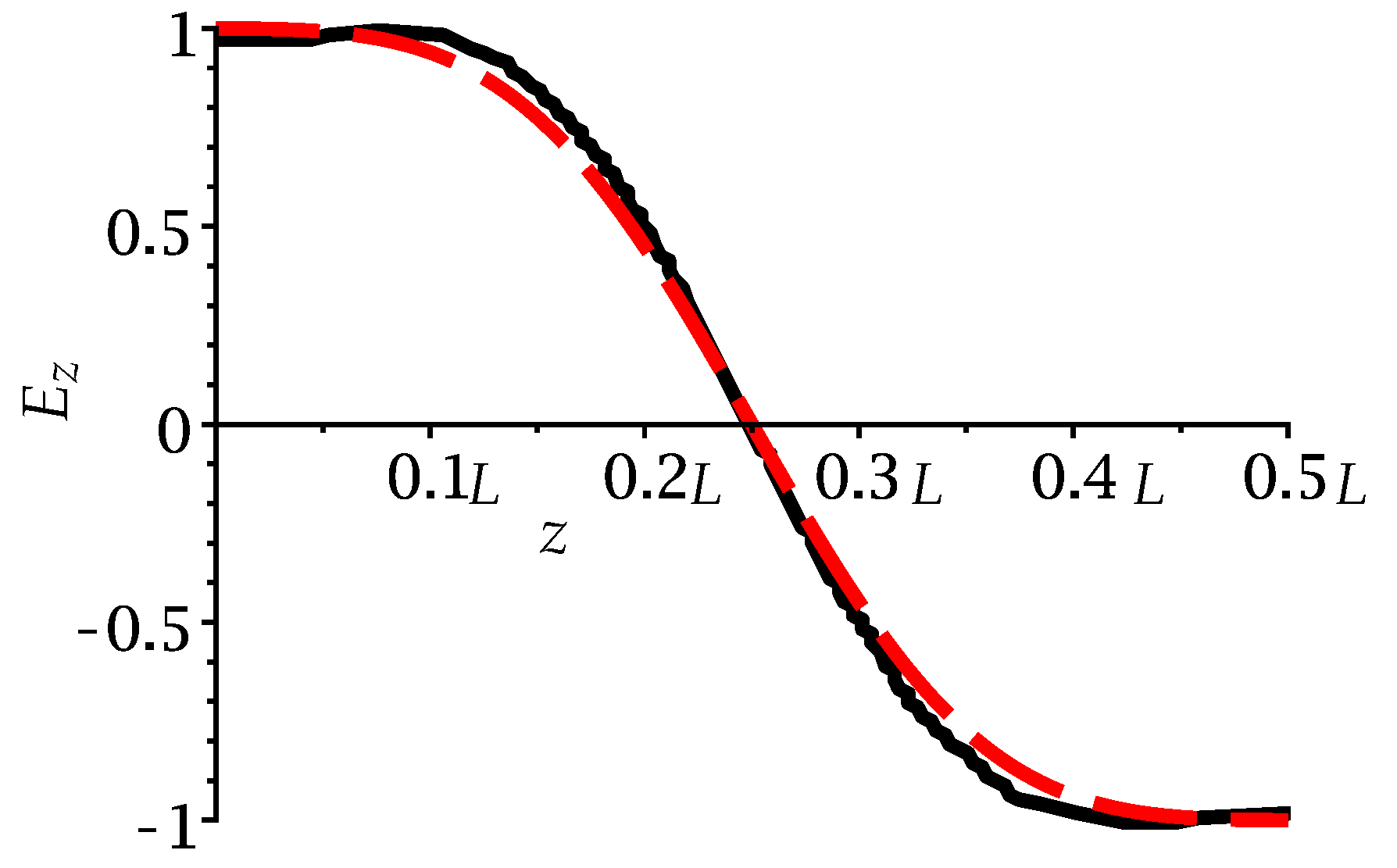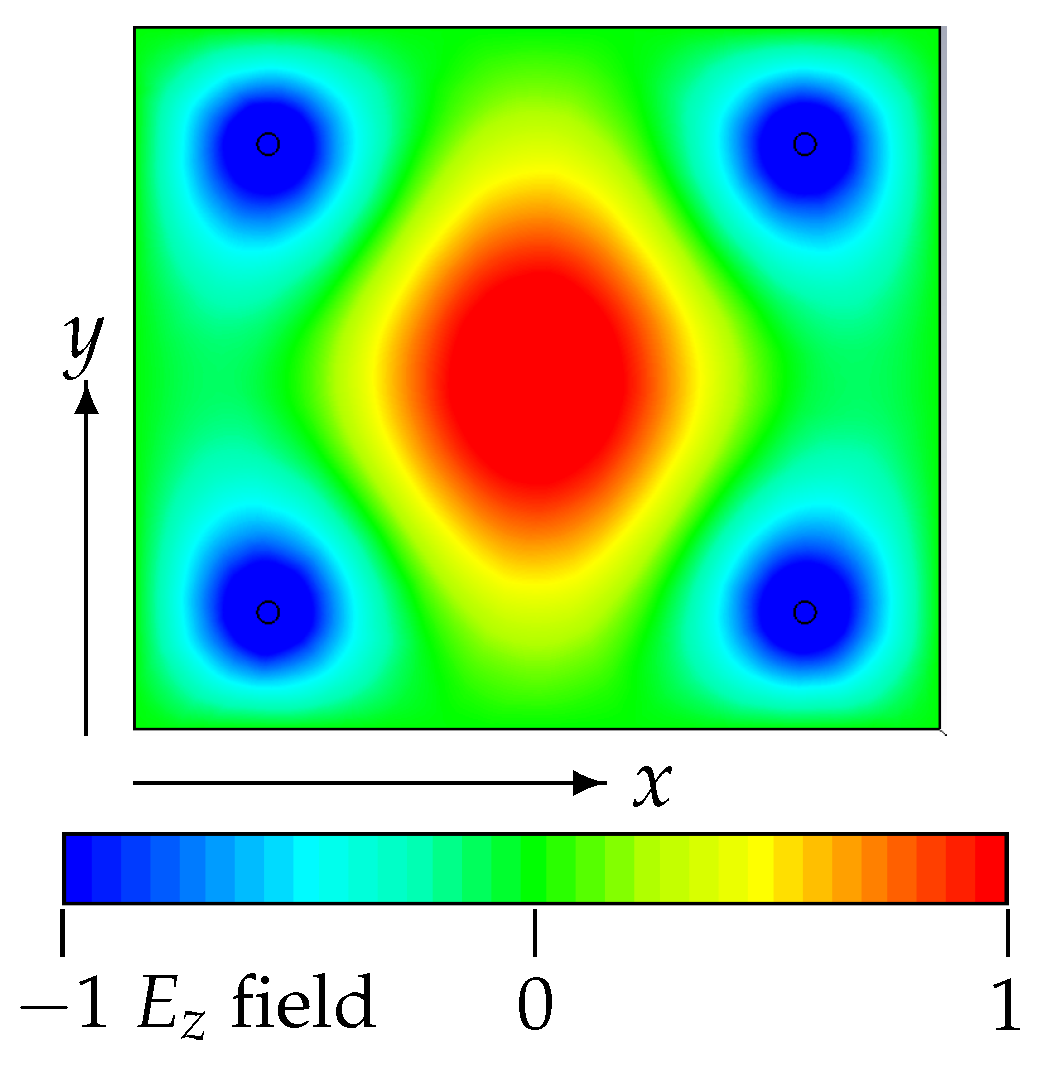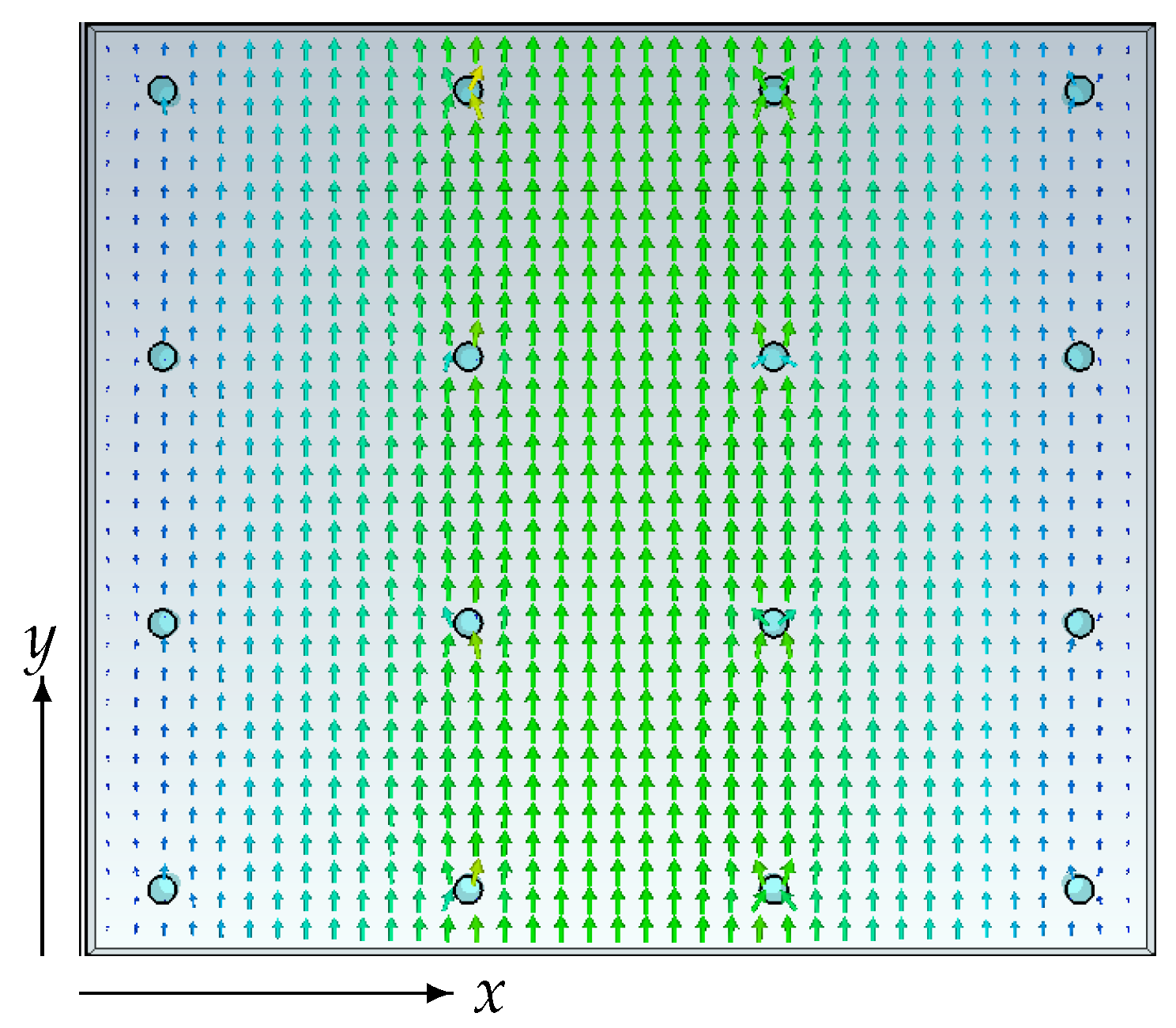1. Introduction
Spatial dispersion is a valuable tool, which can be used to customise the profiles of electric fields in metamaterial and photonic structures. As we have already shown [
1,
2,
3], such field profile customisation is even possible at the sub-wavelength scale, and does not require exhaustive brute-force computation. Further, for our spatially dispersive wire medium [
3], we show this system can support shaped
longitudinal electric fields. This field profiling is achieved by varying the radius of the wires in a carefully calibrated way. In [
3] the system was numerically modelled as an infinite periodic array of wires, so that the computation only required a single wire with periodic boundary conditions. In addition to periodicity, the simulated wire material had a very high permittivity and concomitantly small radius, features that would be problematic in experiment, both in terms of manufacture and fragility. Nevertheless, we did show that such extreme structures were not necessarily required, since re-scaled calculations indicated the shaping effect would still persist even with lower permittivities and larger wire radii.
Such field profiling has a variety of potential uses. The idea has been implemented by means of harmonic synthesis [
4,
5], and suggested in the context of nonlinearity-induced carrier shocking [
6,
7,
8]. Such shaped waveforms have been suggested as a means of enhancing ionisation in high harmonic generation [
9,
10]. Other shapes could find uses, such as fields with locally high gradients but without a large peak-minimising nonlinear effects, or fields with pronounced peaks and low amplitude elsewhere to improve signal to noise ratios. In particular, we are interested in accelerator applications where the field profile might be used for electron bunch shaping, or as part of a laser wakefield accelerator [
11,
12]. This requires us to improve on our initial idealised simulations and incorporate experimental features such as more realistic material choices and a supporting waveguide systems.
In this article, we show that the field profiling of a longitudinal wave predicted in [
3] can be numerically reproduced in an experimentally plausible system. In [
3] we considered an infinite periodic array of infinite wires as shown in
Figure 1, where the wire radius varied from
to
with a relative permittivity of
. As longitudinal electromagnetic waves (EM waves) are known to exist in guided wave systems we consider a
array of finite-wires, a single period long, and contained in a metallic waveguide closed at both ends, as depicted in
Figure 2. In the simulations reported here, our wire parameters are physically easier to realise than those used in [
3], being based on a wire radius that varies from
to
, with a relative permittivity of
. The simulation of this system was undertaken using the frequency domain solver of the commercial software CST Microwave Studio (2018 Update, Framingham, MA, US).
As in [
3] we concentrate on sculpting the electric field profile based on the periodic Mathieu function
where
L is the field wavelength, and the period of variation in the wire radius is
. This field profile has a flatter maximum than a sinusoid, and a steeper gradient when passing though zero. The Mathieu functions are the solution to the differential equation
The periodic solution
in (
1), is given when
,
and
.
2. Modulated Wire Media
This work is based on the understanding of wire media, a class of metamaterials consisting of a regular (rectangular) array of parallel wires or rods, whose radius is small compared to their spacing [
13,
14]. When the wire radii also vary, such three-dimensional inhomogeneous media are difficult to analyse in the absence of a simpler model for the system. Fortunately, the fixed-radius case is understood [
13], which provides us with a starting point.
Any (fixed-radius) wire medium has an electromagnetic dispersion which follows the hydrodynamic Lorentz model, with a dependence on a resonance frequency, a polariton velocity, and a plasma frequency. In [
3] we showed that, in effect, we could assume this held for any thin transverse slice of a wire medium. Thus, by stacking different wire radius slices together, to form not a uniform but a varying wire, we would construct a medium where the plasma frequency changed with position. This varying plasma frequency then leads to a correlated change in the effective local refractive index, thus—according to the electromagnetic wave equation—also changing the local curvature of the electric field profile. Since this curvature control changes the shape of the resulting wave, we can calculate how to link any desired field profile to a variation in wire radius.
This procedure, despite its efficiency, is still reliant on numerics. The analytic calculation of Belov et al. [
13] was for infinitely thin wires, and so lacked the radius dependence we rely on to control their spatially dispersive properties. However, once we complete the step of numerically characterising a set of finite radius wires covering a suitable range of sizes, we can easily extract the necessary radius dependence of the plasma frequency. Please note that although the other hydrodynamic Lorentz parameters fitted to the numerical results do change, they are much less sensitive, and so that variation can be reasonably ignored.
3. Modulated Wires in A Supporting Waveguide or Cavity
For either an experimental configuration or a technological application, we would not expect to be able to use an unsupported array of wires in free space. Instead, we would need to use a finite array of wires in a supporting structure such as a metal waveguide or metallic cavity. Further, we would need to arrange the wires within that support so that the longitudinal field structure and the ability to sculpt the profiles is not disrupted or lost.
We choose to model a supporting structure that consists of either a metallic waveguide or cavity, aligned with a rectangular array of wires with varying radius. This leaves several design parameters to consider, (a) the (minimum) number of wires to place in the waveguide or cavity; (b) the distance of the waveguide or cavity side-walls parallel to the wires from the nearest wire, and; for a cavity, (c) the separation of the cavity end-walls perpendicular to the wires and their placement with respect to the modulation of the wires.
Given that the original simulations [
3] were for an infinite periodic array of wires, we might expect that a large array of many wires would be necessary. However, we will see below that good results can be achieved with only a
array; nevertheless in this article we concentrate on a
array as we expect it may offer experimental advantages. Given such a finite array, we now need to consider the positioning of the side-walls, which would ideally be placed where the longitudinal field is small. Please note that in
Figure 3c we see there is an approximately circular region around the wire where the (longitudinal)
is zero. However, the
contour is not only curved in contrast to the planar side-walls of our waveguide or cavity, but its distance from the wire varies with the wire radius as shown on
Figure 4. Nevertheless, a reasonable compromise is possible since it turns out only requiring
is sufficient.
The first step when using our algorithm, detailed in [
3], is to check that our proposed waveguide containing a
array of uniform wires does indeed support longitudinal modes. As can be seen on
Figure 5, strong longitudinal fields are indeed present in the centre between the inner wires. Next, we need to calculate the relationship between the wire radius
r and the plasma frequency
, and the results are shown on
Figure 6 for the
case. Our exponential fit to that data is used simply because it provides a good match to the data – as yet we have no theoretical reasons for the behaviour, although the accuracy of the fit strongly suggests that an explanation could be found. Note, however, that as we are modelling dielectric wires, it is not straightforward to apply arguments based on the Drude model and free carrier concentrations. For our chosen field profile, we use this information to calculate the generating radius variation, as seen on
Figure 7. This produced a shaped longitudinal field shown in
Figure 8, and which is compared with the desired profile on
Figure 9.
The next step was to consider the case of a cavity rather than the infinite wavguide which requires us to choose where to place the perpendicular end-walls. In this case we made the straightforward decision to place them where the field has a symmetry, i.e. at its maximum and minimum values. Thus the cavity contains an exact half wavelength of the field, which is the same as one full period of the wire variation. We see in
Figure 10 that the longitudinal profile of the mode is unaffected and from
Figure 11 that the simulated field profiles is still in very good agreement with the intended Mathieu profile. We also repeated the above procedure for the simpler cavity with only a
wire array, as shown on
Figure 12 and
Figure 13. Even in this reduced situation there was still excellent agreement with the desired electric field profile.
4. Frequency Isolation
When attempting to experimentally demonstrate profile shaping it is necessary to not merely excite the appropriate mode in the structure, but also excite
only that mode. In particular, we need to be able to avoid exciting the nearby modes which may not be longitudinal, nor be correctly shaped. To assist with this selection, in
Table 1 we show an eigenmode analysis for the cavity in the vicinity of the index 90 (
GHz) mode we wish to excite. At first sight this does not look promising, with nearby modes being within 0.1% (i.e. about
GHz). However, we can also see that the nearest modes are transverse (as in
Figure 14) rather than longitudinal, so that they should not be strongly excited as long as we only attempt to excite the desired mode with a well designed source. The nearest unwanted longitudinal mode is further away in frequency (about 0.9% or
GHz), so it need not present too much of a challenge if we can constrain the bandwidth of the mode and source sufficiently.
5. Conclusions and Future Work
We have presented evidence that it should be possible to reproduce the field profile shaping results of [
3] in an experimentally realisable system. The system consists of a finite number of wires, a single period long, inside a metal cavity, and despite the many potential difficulties introduced by the cavity, simulations still show that we can modify the profile of the longitudinal electric field at will. Further, the shaped mode that we intend to excite should be sufficiently distinct from other nearby modes to allow the effect to be observed in practise. Nevertheless, more work is needed to improve this separation, either by identifying better methods of frequency isolation or by exploiting the properties of the nearby modes.
Despite these promising predictions, there are other practical challenges that need to be overcome. We know that wires with a relative permittivity of can be produced from a composite blend of particles and plasticiser, but thin wires with radii between and may be impractical to work with, even via controlled extrusion. If such manufacturing constraints cannot be overcome, we can easily redesign the system to use a larger cavity, work at a lower frequency, and need lower permittivity wires. Of course such adjustment will need to be led by the actual experimental design and lessons learned during its implementation and testing.
Beyond the challenges involved in construction of the field profile shaping apparatus, there is also the question of what is the best method for exciting the longitudinal modes, and what the best way to measure them. One approach would be to load a sample of our wire array media into a section of a larger waveguide. In this way the naturally occurring longitudinal wave of the bare waveguide could couple naturally to the longitudinal (and shaped) wave in the loaded section, with minimal effect on the unwanted – but nearby in frequency – transverse modes. For measurement, a probe attached to a spectrum analyser can be used to map the internal field profile, or, alternatively, a perturbation bead-pull approach could be used.
In summary, we believe our simulations provide sufficient evidence that our field profile shaping method will work in practise; justifying our intent to proceed with designing and building an experiment to verify this. Nevertheless, the frequency domain simulations done here could still be extended upon – notably we would like to move forward to time domain simulation to provide more information, such as to how the field profile will build up in the wire array media when the excitation field is turned on.

